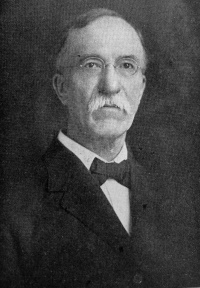

Francis Perry Dunnington (3 March 1851–3 February 1944), chemist and educator, was born in Baltimore, Maryland, and was the son of William Augustus Dunnington and Sarah Brice Keener Dunnington. He matriculated at the University of Virginia at age sixteen in 1867 and graduated as a Phi Beta Kappa with a B.S. in chemistry in 1871. The following year he received the degree of Civil and Mining Engineer from the university. Dunnington married Marion Sterling Beale in Fredericksburg on 20 August 1878. They had four daughters.
Dunnington joined the faculty at the University of Virginia as an adjunct professor of analytical and agricultural chemistry in 1872 and was promoted to full professor eight years later. He also lectured in the pharmacy department after its establishment in 1886. In 1908 he received an appointment as professor of analytical and industrial chemistry. Red-haired and imposing as a younger man, Dunnington was known by his students and friends for his thoroughness, patience, kindness, and fairness and was nicknamed "Old Dunny." He took a personal interest in his students and on at least one occasion took an ill student into his home and ensured that the young man was cared for until he had fully recovered. In 1894, when the university faculty considered the question of admitting women, Dunnington was one of the minority of professors who supported the proposition.
Over the course of his long career, Dunnington wrote more than sixty scientific papers. In 1881 and 1882 he published a series of "Letters to Farmers" in the Charlottesville Jeffersonian Republican on soil conservation. In an article in the December 1891 issue of the American Journal of Science, Dunnington described results of the research he had been undertaking since at least 1885 and for which he is best known, showing that titanium oxide, a white pigment used in a variety of materials from ceramics to sunscreen, is extensively distributed in soils and rocks throughout the world. Many of his papers appeared in the Journal of Analytical and Applied Chemistry and the Journal of Industrial and Engineering Chemistry. A series of papers, collectively entitled "Notes of Work by Students of Practical Chemistry in the Laboratory of the University of Virginia" and published between the 1870s and the 1890s in several scholarly chemistry journals, incorporated reports of research done by and with his students.
Dunnington often presented papers at scientific conferences and belonged to numerous professional organizations. Named a fellow of the American Association for the Advancement of Science in 1880, he served as secretary of its chemical section in 1885. In recognition of his contributions to science, the Chemical Society of London elected him a fellow in 1893. The following year the American Chemical Society admitted Dunnington to membership, and he sat on the executive committee of its Washington chapter in 1914. He received the Charles Herty Medal in 1935 for his contributions to the industrial progress of the South, especially as an educator of chemists and engineers.
Dunnington contributed to the welfare of the university and the Charlottesville community. He strongly recommended and personally supervised the installation of modern sewage systems in more than one hundred university buildings. A longtime temperance advocate, he sat on the executive committee of the Anti-Saloon League of Virginia for more than twenty years. Dunnington retired from full-time teaching in 1919 but received laboratory privileges to continue his research. He also became curator of the university's chemical museum, which he helped reorganize following a disastrous fire in 1917. An avid gardener in retirement, he cultivated apples and pears. Francis Perry Dunnington died of arteriosclerosis at his Charlottesville home on 3 February 1944. He was buried next to the remains of his wife, who had died on 12 November 1936, in the University of Virginia Cemetery and Columbarium.
Sources Consulted:
Biographies in Industrial and Engineering Chemistry 22 (1930): 1408–1409, and Virginia Section of the American Chemical Society Bulletin 9 (Oct. 1931): 9–10 (portrait); Marriage Register, Fredericksburg, Bureau of Vital Statistics (BVS), Commonwealth of Virginia Department of Health, Record Group 36, Library of Virginia (LVA); Francis Perry Dunnington Papers, Albert and Shirley Small Special Collections Library, University of Virginia, Charlottesville; publications include Dunnington, "Distribution of Titanic Oxide upon the surface of the Earth," American Journal of Science, 3d ser., 42 (Dec. 1891): article 53, 491–495; David M. R. Culbreth, The University of Virginia: Memories of Her Student-Life and Professors (1908), 439–441 (portrait facing 422); Richmond Times-Dispatch, 24 Apr. 1935, 11 Dec. 1949; Charlottesville Daily Progress, 10 Jan. 1938; BVS Death Certificate, Charlottesville; obituaries in Charlottesville Daily Progress, 3 Feb. 1944, New York Times, Richmond News Leader, Richmond Times-Dispatch, and Washington Post, all 4 Feb. 1944; memorial in University of Virginia Alumni News 32 (Mar. 1944): 8, reprinted in Science, n.s., 99 (1944): 357–358.
Photograph in American Chemical Society Bulletin, Oct. 1931.
Written for the Dictionary of Virginia Biography by Keir B. Sterling.
How to cite this page:
Keir B. Sterling, "Francis Perry Dunnington (1851–1944)," Dictionary of Virginia Biography, Library of Virginia (1998– ), published 2023 (http://www.lva.virginia.gov/public/dvb/bio.asp?b=Dunnington_Francis_P, accessed [today's date]).
Return to the Dictionary of Virginia Biography Search page.


